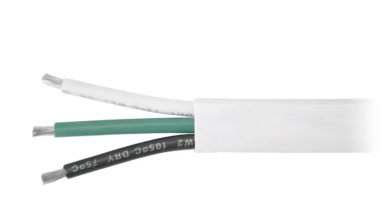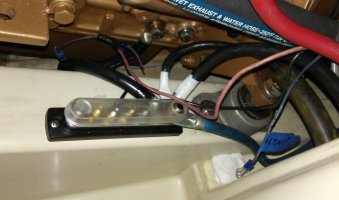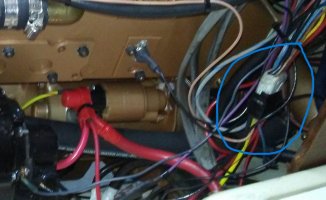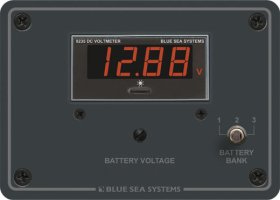Eric Gordon
1975 E27 - Sea Star, Yanmar 3GM30F Dana Point, Ca.
I am, at heart a very simple man.
When I first purchased Sea Star in 2016, I knew absolutely nothing about owning and operating a sailboat of any kind. It can still be said that little has changed. Sure, I can blame about two-years of inactivity on Covid, but, the rest of it is on me.
So over the past 60-days as I have dived back into boat projects, one of the things that I needed to address was power on Sea Star.
The PO, had three batteries, which powered the engine and a wide assortment of sailing accouterment, including RADAR, a half-functioning, button operated airhorn, a stereo system with speakers, a refrigeration system, lights (interior and running), a Lofrans Project 1000 windlass, a macerator, depth sounder, compass light, speed instrument, VHF, and a whole bunch of other little things.
Fast forward to today and I have eliminated almost all of the things I dont want on the boat, either because I simply want things simple, or, as in the case of the refrigerator/cooler system, the thing was all rusty and disgusting.
So a few weeks ago, I began to realize that SOME of the tasks on Sea Star could be accomplished by me, albeit, they would simply take more time. And time, (your favorite non-denominational or exalted being willing), is something I have plenty of.
So I bought a couple of new West marine batteries, and a NOCO charger and installed them. That alone was a harrowing experience, because I have little confidence in swimming about in the mass of cables left by all of those things which needed to be removed, but I got through it and things are working.
So, long story short, I have two West Marine AGM Class 100 Batteries powering the following;
- VHF
- Interior lights (a total of about 4)
- Running lights
- Engine Starter
- Depth Sounder (currently on the fritz)
- Knot Speed Indicator (currently on the fritz)
I want to add the Windlass to the House battery and I wonder: given there is no longer Radar or a macerator or any of the other stuff sucking up power, do you think I will be OK if I have the windlass hooked up to the existing system or would I be better off with a third battery?
And, I would like to run an inverter on the house battery so when I sail down to Oceanside or San Diego, I can run a CPAP or boil some water (no gas stove on board).
Am I talking myself into a third battery?
As always, your thoughts and advice are a welcome learning experience.
You would have thought that, at 70, I would already know some of this %#^@.
When I first purchased Sea Star in 2016, I knew absolutely nothing about owning and operating a sailboat of any kind. It can still be said that little has changed. Sure, I can blame about two-years of inactivity on Covid, but, the rest of it is on me.
So over the past 60-days as I have dived back into boat projects, one of the things that I needed to address was power on Sea Star.
The PO, had three batteries, which powered the engine and a wide assortment of sailing accouterment, including RADAR, a half-functioning, button operated airhorn, a stereo system with speakers, a refrigeration system, lights (interior and running), a Lofrans Project 1000 windlass, a macerator, depth sounder, compass light, speed instrument, VHF, and a whole bunch of other little things.
Fast forward to today and I have eliminated almost all of the things I dont want on the boat, either because I simply want things simple, or, as in the case of the refrigerator/cooler system, the thing was all rusty and disgusting.
So a few weeks ago, I began to realize that SOME of the tasks on Sea Star could be accomplished by me, albeit, they would simply take more time. And time, (your favorite non-denominational or exalted being willing), is something I have plenty of.
So I bought a couple of new West marine batteries, and a NOCO charger and installed them. That alone was a harrowing experience, because I have little confidence in swimming about in the mass of cables left by all of those things which needed to be removed, but I got through it and things are working.
So, long story short, I have two West Marine AGM Class 100 Batteries powering the following;
- VHF
- Interior lights (a total of about 4)
- Running lights
- Engine Starter
- Depth Sounder (currently on the fritz)
- Knot Speed Indicator (currently on the fritz)
I want to add the Windlass to the House battery and I wonder: given there is no longer Radar or a macerator or any of the other stuff sucking up power, do you think I will be OK if I have the windlass hooked up to the existing system or would I be better off with a third battery?
And, I would like to run an inverter on the house battery so when I sail down to Oceanside or San Diego, I can run a CPAP or boil some water (no gas stove on board).
Am I talking myself into a third battery?
As always, your thoughts and advice are a welcome learning experience.
You would have thought that, at 70, I would already know some of this %#^@.







